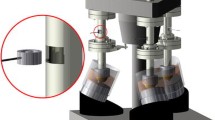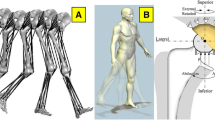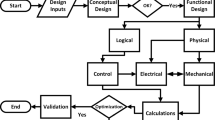Abstract
A new bio-tribological simulator system was designed and built for basic wear tests on artificial hip joint materials and for common tribological studies applications. The module of hip joint simulator is consisted of Flexion and Extension (FE), Abduction and Adduction (AA) and Internal and External Rotation (IER). Preliminary tests were done with a 28 mm CoCrMo femoral head and a Ultra High Molecular Weight Polyethylene (UHMWPE) cup. Results showed that the wear rate was close to the clinical one. A frequency control system and a heating system were developed to offer a wide range of rotation frequency and temperature so as to provide proper experiments. In the Pin-on-Disk (POD) part, eight precision-made pins were generated and an advanced computer system was built up to measure the friction coefficient of the tests samples.
Similar content being viewed by others
References
Revell P A, AlSaffar N, Kobayashi A. Biological reaction to debris in relation to joint prostheses. Proceedings of Institution Mechanical Engineering, 1997, 211, 187–197.
Stewart T D, Tipper J L, Insley G, Streicher R M, Ingham E, fisher J. Long-term wear of ceramic matrix composite materials for hip prostheses under severe swing phase microseparation. Journal of Biomedical Materials Research B, 2003, 66, 567–573.
Wang A, Stark C, Dumbleton J H. Mechanistic and morphological origins of ultra-high-molecular-weight- polyethylene wear debris in total joint replacement prostheses. Proceedings of the Institution Mechanical Engineers H, 1996, 210, 141–155.
Tworzydlo W W, Hamzeh O N, Zaton W, Judek T J. Friction-induced oscillations of a pin-on-disk slider: Analytical and experimental studies. Wear, 1999, 236, 9–23.
Ramamurti B S, Bragdon C R, O’Connor D O, Lowenstein J D, Jasty M, Estok D M, Harris W H. Loci of movement of selected points on the femoral head during normal gait. Three-dimensional computer simulation. Journal of Arthroplasty, 1996, 11, 845–852.
Wang A, Sun D C, Yau S S, Edwards B, Sokol M, Essner A, Polineni V K, Stark C, Dumbleton J H. Orientation softening in the deformation and wear of ultra-high molecular weight polyethylene. Wear, 1997, 203, 230–241.
Johnston R C, Smidt G L. Measurement of hip-joint motion during walking-evaluation of an electrogoniometric method. The Journal of Bone Joint Surgery, 1969, 51, 1083–1094.
Saikko V, Calonius O. Slide track analysis of the relative motion between femoral head and acetabular cup in walking and in hip simulators. Journal of Biomechanics, 2002, 35, 455–464.
Calonius O, Saikko V. Analysis of relative motion between femoral head and acetabular cup and advances in computation of the wear factor for the prosthetic hip joint. Acta Polytechnica, 2003, 43, 43–54.
Calonius O, Saikko V. Slide track analysis of eight contemporary hip simulator designs. Journal of Biomechanics, 2002, 35, 1439–1450.
Atkinson J R, Dowson D, Isaac G H, Wroblewski B M. Laboratory wear tests and clinical observations of the penetration of femoral heads into acetabular cups in total replacement hip joints III: The measurement of internal volume changes in explanted charnley sockets after 2–16 years in vivo and the determination of wear factors. Wear, 1985, 104, 225–244.
Essner A, Schmidig G, Wang A. The clinical relevance of hip joint simulator testing: In vitro and in vivio comparisons. Wear, 2005, 259, 882–886.
Seireg A, Arviter R J. The prediction of muscular load sharing and joint forces in the lower extremities during walking. Journal of Biomechanics, 1975, 8, 89–102.
Hua Z K, Su S H, Zhang J H. Tribological study on new therapeutic bionic lubricants. Tribology Letters, 2007, 28, 51–58.
Author information
Authors and Affiliations
Corresponding author
Rights and permissions
About this article
Cite this article
Hua, Z.K., Zhang, J.H. A New Simulator for Bio-Tribological Study. J Bionic Eng 5 (Suppl 1), 143–147 (2008). https://doi.org/10.1016/S1672-6529(08)60085-2
Published:
Issue Date:
DOI: https://doi.org/10.1016/S1672-6529(08)60085-2




